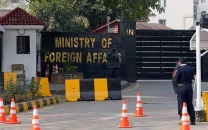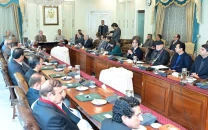Backstage II: it’s serious business
If theatre artistes keep generating slapstick humour on TV talk shows, we will be a laughing stock of global audience.

Today, theatre is taking an entirely new but bizarre shape, something which is beyond the ambits of commercial and non-commercial theatres as we know them. This strange category of theatre is presented in the form of dialogue on television talk shows, which intermingles both the tools and talent usually seen in commercial theatre.
There are three dimensions to this new theatre: politics, farce and theatrics. Every news channel is presenting its own form of such theatre; while some have hired three mainstream stage comedians or improvisers, some rely on one to get the desired result. The only difference is that those who used to stand in front of a live audience and deliver their jokes now sit in front of the camera and do it. Similarly, the audience that used to go to theatre halls to enjoy their talent now enjoys it in the comfort of their homes.
In a nutshell, theatre is being wrapped in a packing of current affairs and delivered from doorstep to doorstep. This is the latest version of theatre in Pakistan. People may beg to differ on the premise that with theatre translating into the medium of television, it can no longer be counted as theatre. But the irony is that ‘theatre’ has never been performed on the commercial theatre stage in Pakistan. They were all just stage dramas.

Although Firdous Jamal once disagreed with me on this and argued that him and actors such as Subhani Ba Younus have actually performed ‘theatre’ in Lahore. But the face of Karachi’s theatre, Zia Mohyeddin, believes that theatre has never been performed in Karachi.
By the ‘latest version’ of theatre, I’m suggesting that the relationship between the audience and the performer has remained the same, but the stage is missing. And those people who still go to theatre halls to watch ‘Eid dramas’ will soon get bored of their redundant content and eventually begin preferring television shows such as Khabarnaak, Siyasi Theatre and Hasb-e-Haal. This way, commercial theatre, as we know it, is going to die its own death. After all, a dancing diva is not always enough to rivet the audience’s attention.
National Academy of Performing Arts (Napa) is the only place where theatre is being presented in its true form, but it seems as if that is their crime, as no one really comes to watch their plays. Despite the fact that they spend months rehearsing Urdu adaptations of classic plays, only a few viewers occupy seats for their shows.
It is imperative for the progress of theatre that the audience takes it seriously, but if people don’t show up for such shows, then the important question is that who is to blame for this? Is Napa to be held liable for the fact that only a few people know that a government-funded performing arts academy exists and is run by theatre heavyweights? Or is it just a lack of seriousness on the audience’s side?
A number of well-known actors in Hollywood and Bollywood originated from theatre and the same can happen in Pakistan only if we keep quality theatre alive — not just an extension of stage dramas. Recently, an international performing arts festival was held at Napa where artistes from all across the globe performed in front of local audiences.
This festival sent a message of peace and tolerance, but if it gets limited to generating slapstick humour on television, we will become the butt of jokes for the world. The Government of Pakistan and related units should contribute to the progress of theatre in Pakistan because culture and heritage are the true representation of society.
The story is the second of a two-part series revolving around the dichotomy of commercial and non-commercial theatre in Pakistan. It was originally published in Roznama Express.
Translated by: RAFAY MAHMOOD
Published in The Express Tribune, August 6th, 2014.
Like Life & Style on Facebook, follow @ETLifeandStyle on Twitter for the latest in fashion, gossip and entertainment.



















COMMENTS
Comments are moderated and generally will be posted if they are on-topic and not abusive.
For more information, please see our Comments FAQ